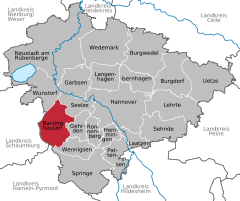Barsinghausen
| Barsinghausen | ||
|---|---|---|
| ||
 Barsinghausen | ||
Location of Barsinghausen within Hanover district 
 | ||
| Coordinates: 52°18′0″N 9°28′52″E / 52.30000°N 9.48111°ECoordinates: 52°18′0″N 9°28′52″E / 52.30000°N 9.48111°E | ||
| Country | Germany | |
| State | Lower Saxony | |
| District | Hanover | |
| Government | ||
| • Mayor | n.n. | |
| Area | ||
| • Total | 102.65 km2 (39.63 sq mi) | |
| Population (2015-12-31)[1] | ||
| • Total | 33,608 | |
| • Density | 330/km2 (850/sq mi) | |
| Time zone | CET/CEST (UTC+1/+2) | |
| Postal codes | 30890 | |
| Dialling codes | 05105 | |
| Vehicle registration | H | |
| Website | www.barsinghausen.de | |
Barsinghausen is a town in the district of Hanover, in Lower Saxony, Germany. It is situated at the Deister chain of hills approx. 20 km west of Hanover. Barsinghausen belongs to the historic landscape Calenberg Land and was first mentioned in 1193.


Geography
Neighbouring places
Barsinghausen adjoins Wunstorf, Seelze, Gehrden, Springe, Bad Nenndorf and Wennigsen.
Division of the town
Barsinghausen consists of 18 districts: Bantorf, Barrigsen, Barsinghausen, Eckerde, Egestorf, Göxe, Großgoltern, Nordgoltern, Groß Munzel, Hohenbostel, Holtensen, Kirchdorf, Landringhausen, Langreder, Ostermunzel, Stemmen, Wichtringhausen, Winninghausen
History
Barsinghausen is the site of an old double monastery (“Kloster Barsinghausen”) that was established during the High Middle Ages. At that time, fertile loess soil and a number of influent streams to river Südaue constituted a central fundament for farming and numerous windmills in Calenberg Land. Barsinghausen became a coal mining town between 1871 and 1957. After World War II, other sectors of industry began to dominate Barsinghausen's economy.
Population History
(each time at 31 December)
- 1998 - 34,743
- 1999 - 34,648
- 2000 - 34,497
- 2001 - 34,408
- 2002 - 34,370
- 2003 - 34,376
- 2004 - 34,253
Main sights
Barsinghausen is home to “Kloster Barsinghausen” a nunnery first mentioned in 1193 AD (now a Lutheran women's convent, to Monastery Church St. Mary (“Marienkirche”), to the Deister Open Air Theater (“Deister Freilichtbühne”), to the exhibition mine “Klosterstollen”, to Sport Hotel Fuchsbachtal and to Lower Saxony's Soccer Association. The Colossus of Ostermunzel is a glacial erratic qualified as a natural monument.[2] Its large size is abnormal, particularly for northern Germany and especially for Lower Saxony.[3]
Schools
Elementary schools
- Adolf-Grimme-Schule
- Wilhelm-Stedler-Schule
- Ernst-Reuter-Schule
- Astrid-Lindgren-Schule
- Albert-Schweitzer-Schule
- Grundschule Groß Munzel
- Grundschule Hohenbostel
- Grundschule Bantorf
Secondary Schools
Special Schools
- Bert-Brecht-Schule (Special education school)
- VHS (Volkshochschule - Adult high school) Calenberger Land
Personality
Sons and daughters of the town
- Hartmut Andryczuk, publisher
- Herbert Lattmann, former member of the Bundestag (CDU)
- Kurt Sohns, (1907-1990), painter, artist, professor at the Technical University of Hannover
Other personalities who are associated with the city
- Heinz Erhardt, (1909-1979), actor and comedian, attended from 1919 to 1924 a boarding school in Barsinghausen
- Herbert Gruhl, (1921-1993), politician and author (Ein Planet wird geplündert (1975))
- Hans-Joachim Mack, (1928-2008), General of the Bundeswehr,
- Robert Schulz (1900-1974), SS brigade leader in Nazism, member of the Reichstag, lived and worked after 1945 as a civil servant in Barsinghausen
References
- ↑ Landesbetrieb für Statistik und Kommunikationstechnologie Niedersachsen, 102 Bevölkerung - Basis Zensus 2011, Stand 31. Dezember 2015 (Tabelle K1020014)
- ↑ Wie ein Milliarden Jahre alter Stein die Geheimnisse der Eiszeit lösen könnte in focus.de of 16 March 2015
- ↑ Klaus Abelmann: Gehoben und verschoben: Der Findling von Ostermunzel in: Deisterjournal.
External links
| Wikimedia Commons has media related to Barsinghausen. |
- Official site (German)
